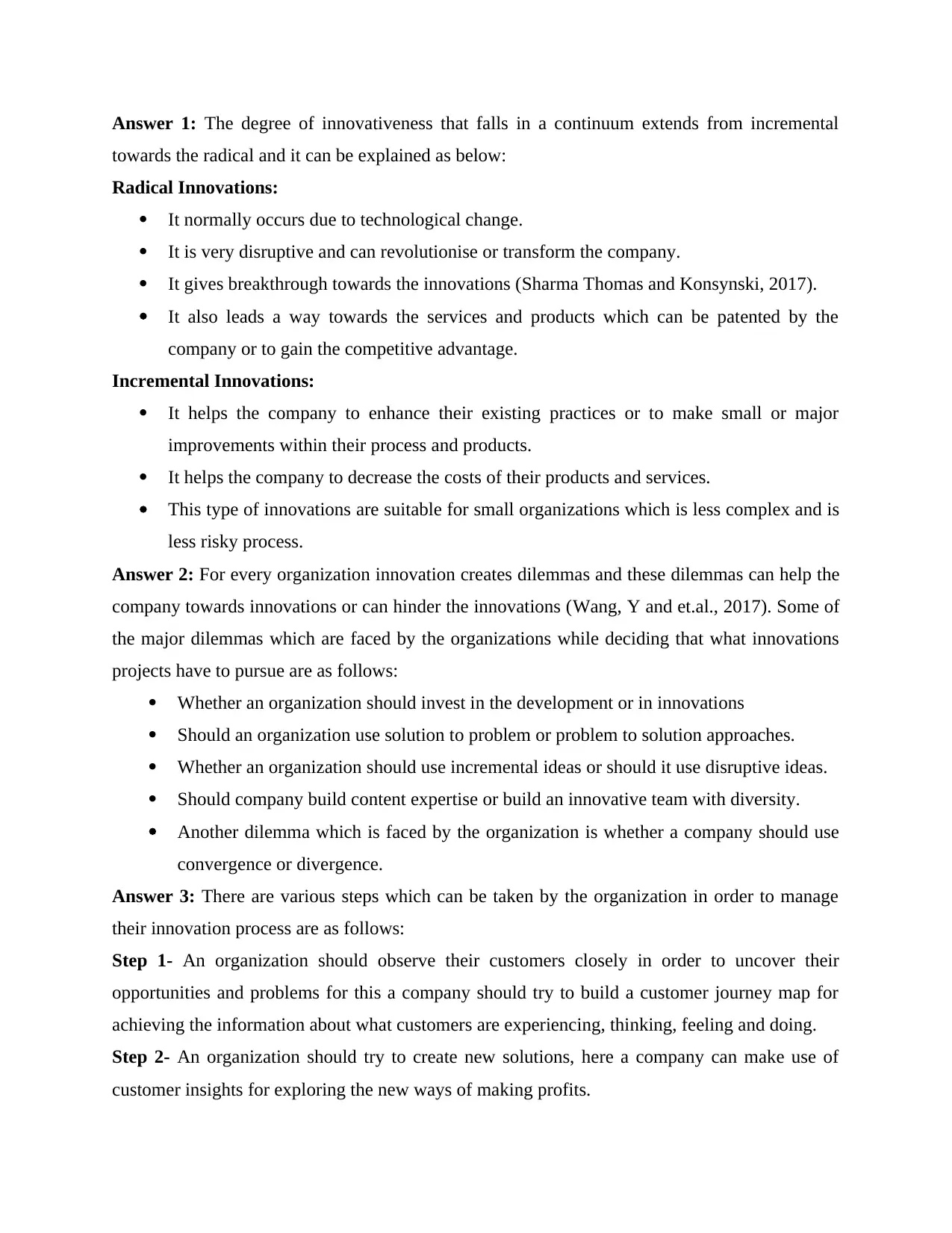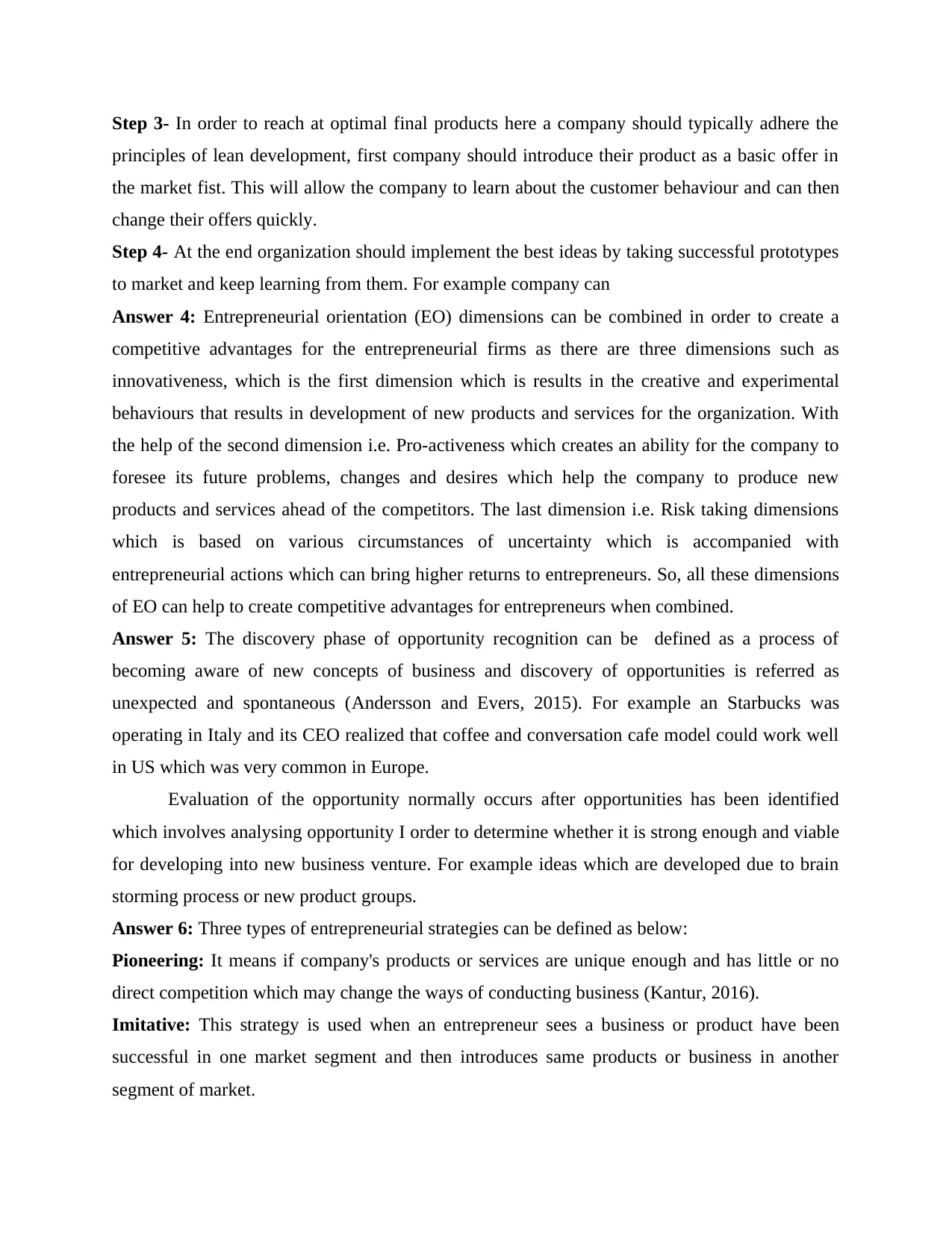Strategic Management Homework Assignment Solutions and Answers
VerifiedAdded on 2021/02/19
|5
|1022
|329
Homework Assignment
AI Summary
This assignment solution provides detailed answers to key questions in strategic management. It explores the spectrum of innovation from incremental to radical, discussing their impacts and implications. The document addresses the dilemmas organizations face when pursuing innovation, such as investment choices and approaches to problem-solving. It also outlines a step-by-step process for managing innovation, emphasizing customer insights and lean development. Furthermore, the solution examines entrepreneurial orientation (EO) dimensions and how they create competitive advantages. It defines the discovery and evaluation phases of opportunity recognition, using the example of Starbucks. Finally, it explains three types of entrepreneurial strategies: pioneering, imitative, and adaptive, providing a comprehensive overview of strategic management concepts.

Strategic Management
Paraphrase This Document
Need a fresh take? Get an instant paraphrase of this document with our AI Paraphraser

Answer 1: The degree of innovativeness that falls in a continuum extends from incremental
towards the radical and it can be explained as below:
Radical Innovations:
It normally occurs due to technological change.
It is very disruptive and can revolutionise or transform the company.
It gives breakthrough towards the innovations (Sharma Thomas and Konsynski, 2017).
It also leads a way towards the services and products which can be patented by the
company or to gain the competitive advantage.
Incremental Innovations:
It helps the company to enhance their existing practices or to make small or major
improvements within their process and products.
It helps the company to decrease the costs of their products and services.
This type of innovations are suitable for small organizations which is less complex and is
less risky process.
Answer 2: For every organization innovation creates dilemmas and these dilemmas can help the
company towards innovations or can hinder the innovations (Wang, Y and et.al., 2017). Some of
the major dilemmas which are faced by the organizations while deciding that what innovations
projects have to pursue are as follows:
Whether an organization should invest in the development or in innovations
Should an organization use solution to problem or problem to solution approaches.
Whether an organization should use incremental ideas or should it use disruptive ideas.
Should company build content expertise or build an innovative team with diversity.
Another dilemma which is faced by the organization is whether a company should use
convergence or divergence.
Answer 3: There are various steps which can be taken by the organization in order to manage
their innovation process are as follows:
Step 1- An organization should observe their customers closely in order to uncover their
opportunities and problems for this a company should try to build a customer journey map for
achieving the information about what customers are experiencing, thinking, feeling and doing.
Step 2- An organization should try to create new solutions, here a company can make use of
customer insights for exploring the new ways of making profits.
towards the radical and it can be explained as below:
Radical Innovations:
It normally occurs due to technological change.
It is very disruptive and can revolutionise or transform the company.
It gives breakthrough towards the innovations (Sharma Thomas and Konsynski, 2017).
It also leads a way towards the services and products which can be patented by the
company or to gain the competitive advantage.
Incremental Innovations:
It helps the company to enhance their existing practices or to make small or major
improvements within their process and products.
It helps the company to decrease the costs of their products and services.
This type of innovations are suitable for small organizations which is less complex and is
less risky process.
Answer 2: For every organization innovation creates dilemmas and these dilemmas can help the
company towards innovations or can hinder the innovations (Wang, Y and et.al., 2017). Some of
the major dilemmas which are faced by the organizations while deciding that what innovations
projects have to pursue are as follows:
Whether an organization should invest in the development or in innovations
Should an organization use solution to problem or problem to solution approaches.
Whether an organization should use incremental ideas or should it use disruptive ideas.
Should company build content expertise or build an innovative team with diversity.
Another dilemma which is faced by the organization is whether a company should use
convergence or divergence.
Answer 3: There are various steps which can be taken by the organization in order to manage
their innovation process are as follows:
Step 1- An organization should observe their customers closely in order to uncover their
opportunities and problems for this a company should try to build a customer journey map for
achieving the information about what customers are experiencing, thinking, feeling and doing.
Step 2- An organization should try to create new solutions, here a company can make use of
customer insights for exploring the new ways of making profits.

Step 3- In order to reach at optimal final products here a company should typically adhere the
principles of lean development, first company should introduce their product as a basic offer in
the market fist. This will allow the company to learn about the customer behaviour and can then
change their offers quickly.
Step 4- At the end organization should implement the best ideas by taking successful prototypes
to market and keep learning from them. For example company can
Answer 4: Entrepreneurial orientation (EO) dimensions can be combined in order to create a
competitive advantages for the entrepreneurial firms as there are three dimensions such as
innovativeness, which is the first dimension which is results in the creative and experimental
behaviours that results in development of new products and services for the organization. With
the help of the second dimension i.e. Pro-activeness which creates an ability for the company to
foresee its future problems, changes and desires which help the company to produce new
products and services ahead of the competitors. The last dimension i.e. Risk taking dimensions
which is based on various circumstances of uncertainty which is accompanied with
entrepreneurial actions which can bring higher returns to entrepreneurs. So, all these dimensions
of EO can help to create competitive advantages for entrepreneurs when combined.
Answer 5: The discovery phase of opportunity recognition can be defined as a process of
becoming aware of new concepts of business and discovery of opportunities is referred as
unexpected and spontaneous (Andersson and Evers, 2015). For example an Starbucks was
operating in Italy and its CEO realized that coffee and conversation cafe model could work well
in US which was very common in Europe.
Evaluation of the opportunity normally occurs after opportunities has been identified
which involves analysing opportunity I order to determine whether it is strong enough and viable
for developing into new business venture. For example ideas which are developed due to brain
storming process or new product groups.
Answer 6: Three types of entrepreneurial strategies can be defined as below:
Pioneering: It means if company's products or services are unique enough and has little or no
direct competition which may change the ways of conducting business (Kantur, 2016).
Imitative: This strategy is used when an entrepreneur sees a business or product have been
successful in one market segment and then introduces same products or business in another
segment of market.
principles of lean development, first company should introduce their product as a basic offer in
the market fist. This will allow the company to learn about the customer behaviour and can then
change their offers quickly.
Step 4- At the end organization should implement the best ideas by taking successful prototypes
to market and keep learning from them. For example company can
Answer 4: Entrepreneurial orientation (EO) dimensions can be combined in order to create a
competitive advantages for the entrepreneurial firms as there are three dimensions such as
innovativeness, which is the first dimension which is results in the creative and experimental
behaviours that results in development of new products and services for the organization. With
the help of the second dimension i.e. Pro-activeness which creates an ability for the company to
foresee its future problems, changes and desires which help the company to produce new
products and services ahead of the competitors. The last dimension i.e. Risk taking dimensions
which is based on various circumstances of uncertainty which is accompanied with
entrepreneurial actions which can bring higher returns to entrepreneurs. So, all these dimensions
of EO can help to create competitive advantages for entrepreneurs when combined.
Answer 5: The discovery phase of opportunity recognition can be defined as a process of
becoming aware of new concepts of business and discovery of opportunities is referred as
unexpected and spontaneous (Andersson and Evers, 2015). For example an Starbucks was
operating in Italy and its CEO realized that coffee and conversation cafe model could work well
in US which was very common in Europe.
Evaluation of the opportunity normally occurs after opportunities has been identified
which involves analysing opportunity I order to determine whether it is strong enough and viable
for developing into new business venture. For example ideas which are developed due to brain
storming process or new product groups.
Answer 6: Three types of entrepreneurial strategies can be defined as below:
Pioneering: It means if company's products or services are unique enough and has little or no
direct competition which may change the ways of conducting business (Kantur, 2016).
Imitative: This strategy is used when an entrepreneur sees a business or product have been
successful in one market segment and then introduces same products or business in another
segment of market.
⊘ This is a preview!⊘
Do you want full access?
Subscribe today to unlock all pages.

Trusted by 1+ million students worldwide

Adaptive: This is a strategy which is used by the entrepreneur which lies between pure
pioneering and pure imitation, where products is offered which is sufficiently different or
somewhat new which create value for the customer in order to capture market share (Martin and
Mike, 2019).
pioneering and pure imitation, where products is offered which is sufficiently different or
somewhat new which create value for the customer in order to capture market share (Martin and
Mike, 2019).
Paraphrase This Document
Need a fresh take? Get an instant paraphrase of this document with our AI Paraphraser

REFERENCES
Books and Journals
Andersson, S. and Evers, N., 2015. International opportunity recognition in international new
ventures—a dynamic managerial capabilities perspective. Journal of International
Entrepreneurship. 13(3). pp.260-276
Kantur, D., 2016. Strategic entrepreneurship: mediating the entrepreneurial orientation-
performance link. Management Decision. 54(1). pp.24-43.
Sharma, A., Thomas, D. and Konsynski, B., 2017. Finding the “radicalness” in radical innovation
adoption. Journal of Information Systems Applied Research. 10(2). p.12.
Wang, Y and et.al., 2017. Project customization and the supplier revenue–cost dilemmas: The
critical roles of supplier–customer coordination. Journal of Marketing. 81(1). pp.136-
154.
Online
Martin, R and Mike, D., 2019. Adaptability: The New Competitive Advantage. [Online].
Available Through: <https://hbr.org/2011/07/adaptability-the-new-competitive-
advantage>
1
Books and Journals
Andersson, S. and Evers, N., 2015. International opportunity recognition in international new
ventures—a dynamic managerial capabilities perspective. Journal of International
Entrepreneurship. 13(3). pp.260-276
Kantur, D., 2016. Strategic entrepreneurship: mediating the entrepreneurial orientation-
performance link. Management Decision. 54(1). pp.24-43.
Sharma, A., Thomas, D. and Konsynski, B., 2017. Finding the “radicalness” in radical innovation
adoption. Journal of Information Systems Applied Research. 10(2). p.12.
Wang, Y and et.al., 2017. Project customization and the supplier revenue–cost dilemmas: The
critical roles of supplier–customer coordination. Journal of Marketing. 81(1). pp.136-
154.
Online
Martin, R and Mike, D., 2019. Adaptability: The New Competitive Advantage. [Online].
Available Through: <https://hbr.org/2011/07/adaptability-the-new-competitive-
advantage>
1
1 out of 5
Related Documents
Your All-in-One AI-Powered Toolkit for Academic Success.
+13062052269
info@desklib.com
Available 24*7 on WhatsApp / Email
![[object Object]](/_next/static/media/star-bottom.7253800d.svg)
Unlock your academic potential
Copyright © 2020–2025 A2Z Services. All Rights Reserved. Developed and managed by ZUCOL.




